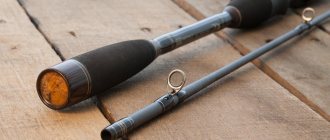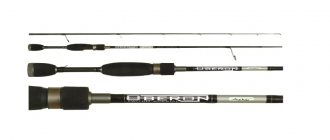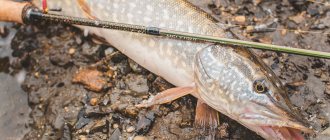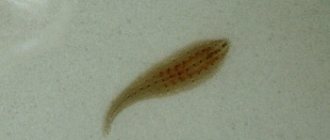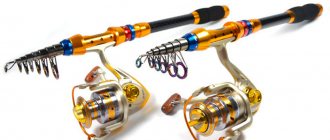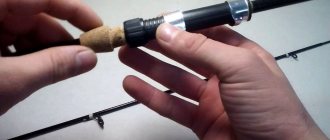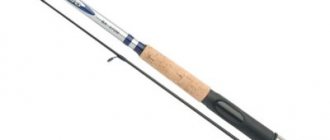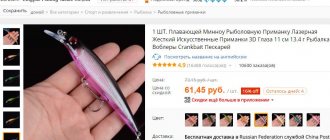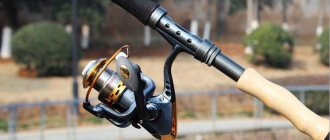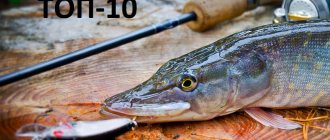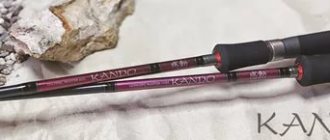The casting rod is increasingly becoming part of the spinning rod's equipment, and this contributes to a significant increase in the comfort of fishing and an increase in its success due to the special thinness of the gear. Thanks to modern innovative materials and the rich fishing experience of spinning players, manufacturers were able to combine the most acceptable parameters for twitching and jigging in a casting spinning rod.
Casting rods are produced in a long line of models that have options for covering many predator fishing conditions, and the presented article will help you most accurately select fishing gear and especially casting gear for novice anglers, taking into account all possible nuances that affect the criteria for a successful fishing session.
What is casting spinning
In spinning slang you can often hear flattering expressions regarding the parameters of trigger gear.
Important! The difference between a casting spinning rod in visual terms and a regular spinning rod lies precisely in the presence of a trigger on the handle of the rod in the models of this series.
The trigger allows you to comfortably hold the fishing rod in your hands, directly controlling the cord with your finger and receiving from tactile sensations the information necessary for the fisherman regarding bait control and bite identification.

In addition, the rings on the rod blank are located in the upper part of its horizon, which provides more opportunities for high-quality and controlled retrieves of all kinds of baits. The winding rings themselves have small diameters and are mounted on the form using reinforced but short legs. Attaching the reel in the form of a worm clamp involves mounting the accessory above the butt of the spinning rod, which is different from ordinary gear in this area for catching predatory fish. A casting rod looks smaller than many spinning rods due to the lightweight blank and handle of the rod, as well as its relatively short length.
Features of casting gear
The main distinguishing feature of casting gear is the use of a multiplier reel on it. In this case, the reel itself, together with the rings, is located on top of the rod, and the trigger for resting the finger is on the bottom. This is done in order to cast over longer distances. The rings themselves are set a little lower than that of a conventional spinning rod, on which a spinning reel is placed.
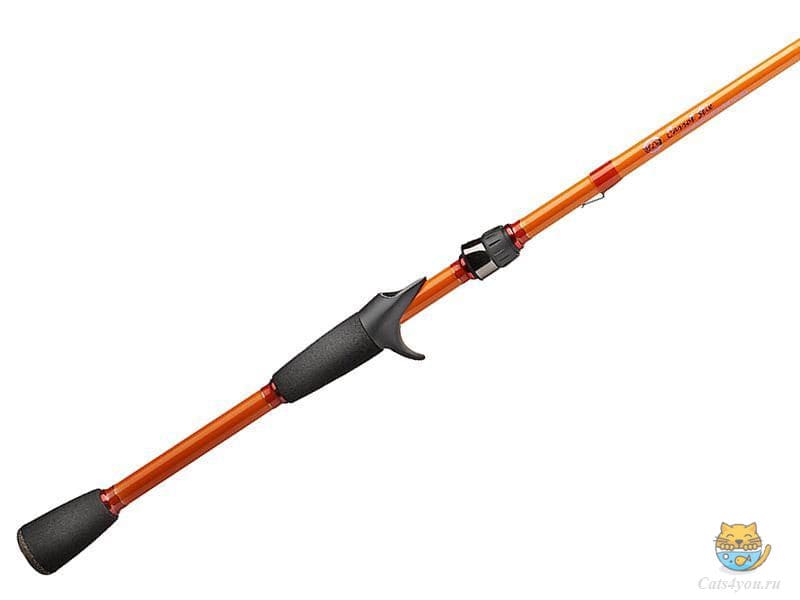
Casting rod: mount for reel and ring on top, trigger on bottom
General rules for choosing a casting spinning rod
A casting spinning rod is selected based on the material of the blank, test, action and length of the rod, as well as the possibilities of high-quality mounting of the baitcasting reel.
Important! It is especially worth noting that these fishing rods are designed for a baitcasting reel, which makes it easier to cast from short poles and use it to produce aggressive animation of baits.

The blank material is selected from the lightest compositions, which include carbon fiber, graphite and carbon fiber. Fiberglass options are quite heavy and not very convenient for dynamic fishing, and it is better not to plan to purchase them at all. Tests of this kind of rods are in small and medium ranges, in numerical values falling in the range from 7 to 40 grams. The length only in exceptional cases reaches three meters. The parameters mainly used are from 1.5 to 2.5 meters. The plug-in assembly method looks preferable. It significantly reduces the likelihood of play than in telescopic versions and has a much lower mass with the same dimensions. Based on the fishing method, let's look at the selection of a fishing rod using examples of jigging and twitching hunting.
How to cast with a casting spinning rod
For a beginner, the matter will seem difficult, although you can master the casting technique in one fishing session. To understand what a casting spinning rod is and to appreciate its advantages, you need to start with a properly equipped fishing rod. For the first time, take an inexpensive rod, but a high-quality reel: with Chinese models you will be disappointed and will not learn casting fishing. There are exceptions to the rules here too: the Sharkey reel is an example of the excellent work of masters from the Middle Kingdom.
Start with a side cast of the bait, perform it powerfully but smoothly. Casting spinning means that your actions are both fast and not harsh. Work with medium weights: light and ultralight weights for experienced anglers. Make sure that the weight of the bait is 2/3 of the rod's weight.
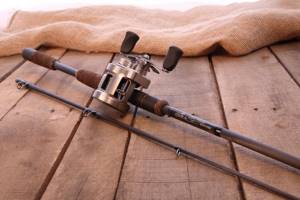
Casting stick with reel
When the side cast becomes confident, move on to a more delicate method - from behind the back. Make a powerful swing with the maximum load of tackle, then gradually reduce the speed of the swing, finally releasing the spool that you were holding with your thumb.
Casting spinning rod for jig
A casting rod for jig is purchased in sizes from 1.9-2.5 meters. The semi-parabolic action is most suitable for jigging. In test ranges, such tackle is more universal in the range from 20 to 40 grams. This level will allow you to fish both shallow waters and deep holes. The graphite and carbon fiber blank of the plug-type assembly will ensure reliability when playing a trophy of fairly substantial size. A casting spinning rod for jig fishing from a boat is selected according to an identical principle, only with an emphasis on selecting the shortest option.
Casting spinning rod for twitching
The twitching casting rod is a short rod, in the range of 1.5-2.1 meters with a semi-fast and fast action. The quivertip is distinguished by its special rigidity, which makes it possible to make distinct jerking movements with wobblers, foam rubber and silicone baits. Tests of these fishing rods include numerical values from 7 to 30 grams; heavy baits are already difficult to animate on these types of retrieves. Carbon fiber blanks most accurately fit the twitching criteria and ensure the reliability of the gear against periodic dynamics. In addition, the properties of this material make the fishing rod much lighter, which has a positive effect on reducing the load on the angler’s hand when performing intense animations and frequent casting of baits.
What is the difference between a casting spinning rod and a regular one?
The protrusion (trigger) is not the only technical feature of a casting rod. There are other differences in design and mechanics:
- The passage rings in such a fishing rod are located along the upper horizon. Casting spinning is like an inverted version of the classic fishing gear for athletes, professionals and amateur fishermen. Rings smaller than the usual diameter are held on short legs with amplifiers. Other fastening (drilling the blank) is prohibited, as it destroys the structure of the fishing rod’s body.
- The reel seat is also located on top of the handle, which allows for better control of bites and jerking retrieves. This is another difference between casting and spinning.
- The casting rod looks smaller: a comfortable, short handle makes the blank much lighter.
The high sensitivity of the gear combined with the ability to make long casts are the reasons why fishermen prefer casting.
But what a casting spinning rod is, the elements of the equipment will help you understand in detail.
Construction type
There are no special features in the structure of the casting rod, except for the handle. Choose a regular spinning stick. There are two types of folding fishing rods based on the method of fastening:
- Plug-in, consisting of several elbows. In this case, the sections are inserted into one another. When disassembled, the knees are separated. The plug connection makes the tackle light, sensitive and durable. You can install the rings according to the form at the distance you need.
- Telescopic, in which the sections slide into each other. The rings are located at the ends of the knees; you cannot change their location.
Only fishing rods with non-separable forms (single-piece) are superior to plugs in terms of sending power. In spinning fishing, two-piece rods are more often used.
Rod test
This is a characteristic of the power and strength of the stick, showing in what range or maximum limits the whip can be loaded with bait.
The English unit of measurement for dough is ounce, the Russian unit is grams. One ounce is equal to 28 g. The indicator is written on the form with two numbers, which indicate the lower and upper limits of the weight of the load.
Their classification is associated with the fishing rod test. There are the following categories with a maximum weight limit for complementary foods:
- ultralight – ultralight – 7 g;
- light – light – 15 g;
- medium-light – medium light – 25 g;
- medium – medium – 35 g;
- medium-heavy – medium heavy – 45 g;
- heavy – heavy – 60 g;
- super heavy – extra heavy – over 60 g.
Each class of fishing rods is used according to fishing circumstances. But the optimal tests for casting are 7-40 g.
Rod build
The whip flexibility parameter, or Young's modulus of elasticity, divides fishing rods into three main groups:
- fast action - only the tip of the fishing rod bends;
- medium action - half the stick bends under load;
- slow action - the entire form bends.
The stiffest rod with a slow action. Its advantage is that the form tactilely better conveys the moment of a bite, but you won’t be able to throw the feeder far.
Rod length
Casting fishing does not require casting distances of more than 100 m on reservoirs and lakes, so long forms are not needed. Choose a rod 1.5-2.5 m, rare cases require a blank length of 3 m.
Material of manufacture
If we do not consider wood and bamboo, the market offers three materials from which you can select a fishing rod:
- Carbon fiber (carbon) is a reliable flexible fibrous material, the most expensive in the segment.
- Fiberglass - costs less than carbon fiber, has lower characteristics. Advantage: light weight.
- Composite material is a budget option, halfway between carbon and fiberglass, suitable for beginners.
Materials, test, structure, and other parameters of the form do not fully explain the difference between spinning and casting. The casting technique gives a better idea of this.
Description of the baitcasting reel
Casting gear must include a multiplier reel in its package. This accessory allows you to widely improvise with wiring methods and quite easily deliver lightly loaded baits to the required fishing spots. The multiplier is of the inertial type of reel, but with a modernized gear mechanism of the winding drum, a finely adjustable braking device and devices to prevent involuntary cord coming off, which prevents tangling during bait casting.
The main requirement for the multi for the presented type of sticks is low weight. Consequently, the housings and mechanisms of the reels are made of light and durable alloys, which together provide a lightweight version of the product and the necessary strength. The capacity of the fishing line receiver for the described gear is not significant in terms of volume. After all, throws to the seventy-meter mark with this type of hunting are quite rare, and the diameters of braided cords and monofilaments used are insignificant in size and almost never exceed 0.2 mm.
Advantages and disadvantages
A casting fishing rod has many advantages that contribute to successful and promising fishing for predatory fish. The most significant advantages include the ergonomic design and high sensitivity of the instrument. In addition, due to the parameters of the pole structure, shifted towards increased rigidity, guiding baits, hooking a trophy and manipulating the landing of caught fish is much easier than with other types of spinning tackle. The variety in the use of baits, high reliability and tactility of sensations when fishing definitely add positivity when considering the features of the presented gear.
The disadvantages include the high cost of casting spinning rods for jigging and twitching, compared to ordinary tools, as well as the difficulty of feeding bait over long distances, which is limited by the short length of the blank and the type of its structure.
Casting fishing technique
Casting fishing involves the use of stepped jigging and jerk twitching. These methods of fishing with a casting spinning rod allow you to accurately deliver the bait to promising fishing spots at short and medium distances and scrupulously control the progress of the retrieve.
Any malfunction of the bait is immediately accompanied by a sharp hook and, if successful, the fisherman carries out the landing. Fishing is carried out using this method both from the shore and from a boat. All kinds of wobblers are used as bait for twitching, with preference given to inert minnows. With the help of jigs, they are mainly caught with silicone and foam rubber baits, using different types of jig heads for the load.
Popular manufacturers of casting spinning rods
When choosing a rod for jigging and twitching, it is better to focus on well-known brands and manufacturers that have been proven for years. Some of them produce a set of equipment that includes the fishing rod itself and a baitcasting reel. This purchase option is most suitable for the fisherman. After all, the company initially balances the accessories against each other and makes the pairing of elements without backlash or interference. This brand includes the Abu Garcia company, popular among spinning players, the Abu Garcia Vendetta 762ML Cast model, which is distinguished by its low cost combined with high quality.
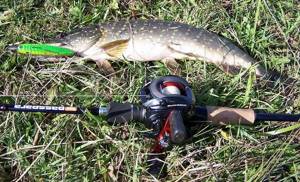
Another popular manufacturer is the Japanese Daiwa, whose line includes models of inexpensive fishing rods Daiwa Procaster and an elite representative in the form of Daiwa Steez. The brand has also developed corresponding cartoons for these models. Ponton 21 can easily be considered one of the top three leaders in the casting industry .
The brand's offerings in the form of the Harrier GAD, Chaser GAD and Gancho GAD will not leave even a novice predator hunter without a catch. When choosing these options for purchase, you need to take into account that you will have to look for the multiplier in the offers of other companies.
Selection of casting spinning rod by type of fish
Cautious and strong predators of Russian water bodies are desirable prey for fishermen. Fishing with a casting spinning rod is aimed at carnivores. You can fish with universal tools. But each individual has its own character and habits, so it is better to choose specific gear for each specific fish.
Pike
Half of the success in catching pike depends on the right tackle. However, fishing from the shore differs from the trolling method, hence the specifics in choosing equipment:
- Whip length. If you are fishing from the shore, you need a cast of up to 70 m. Take a stick of at least 3.5 m. From a boat, the distance is reduced, so a rod of 1.8-2.5 m is sufficient.
- Test. Considering that the toothy huntress does not like strong currents, select a weight for her of up to 40 g.
- Build. Pike goes jigging and twitching. This requires fast and ultra-fast fishing gear.
The material depends on your desires. Don't give up on composite fishing rods, especially if you are a beginner.
Asp
Suspicious fish with keen eyesight quickly notice the catch, so carefully camouflage tackle and bait. You won’t find an asp near the shore; for successful fishing you will have to cast often and far. Hence the parameters of the baitcasting fishing rod:
- length – 2.8-3.2 m;
- build – medium and fast;
- test – 25-30 g;
- bait - jigs, spinners, wobblers, castmasters.
Do not forget about a strong fishing line: the asp provides powerful resistance.
Zander
Look for the inhabitant of fresh and slightly salty waters in clean places: fast-flowing rivers, deep holes with a hard bottom. For voracious pike perch, offer jig wiring, foam rubber and silicone wobblers with recesses.
Assemble a specific fishing kit taking into account:
- high sensitivity;
- large margin of safety;
- sufficient rigidity;
- range.
To do this, you need a form up to 2.8 m long (from a boat - 2.1 m), with a fast action. The weight of the bait is enough for 15-40 g. All parameters are met by spinning rods of the “Gancho” series under the GAD brand.
Perch
The tenacious fish prefers northern cold waters and southern rivers. Perch's favorites are microjig (bait weight less than 5 g), miniature spinners and twitching.
A new type of fishing is quickly gaining popularity - nanojig. Lures weighing less than 1 g turned out to be catchy for finger-sized specimens. The tenacity with which a little thing fights for life evokes respect.
The weight of the prey rarely exceeds a kilogram, so a light and ultra-light fishing rod with a fast action and a test weight of up to 14 g is sufficient. Use braid 0.1 mm in diameter, fishing line - 0.15-0.2 mm. Blank length: for fishing from the shore - up to 270 cm, from a boat - up to 240 cm.
